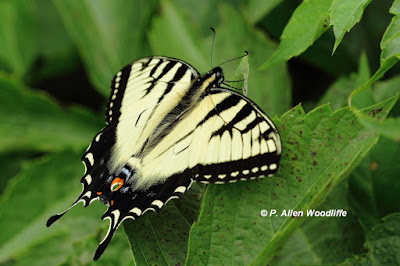With all due respect to Dorothy on the Wizard of Oz, this is not Kansas, and here at Rondeau there are lions and tigers and bears also....and rattlesnakes, too!
Now before you get all worried about fearsome and dangerous wildlife at this nationally significant provincial park....do not worry. These lions, tigers, bears and rattlesnakes are not the dangerous type at all...at least not to anyone reading this.
Let me explain.....
First, the lions: Have you ever been walking along the beach, just in from the edge of the grassy vegetation, and noticed some conical, round depressions in the sand?
A little closer examination, and you can see that although it isn't deep, it is more or less uniform around this inverted cone.
Now imagine if you were a small insect, such as an ant, crawling across the sand, and tumbled down the edge of this pit. Sand, especially the relatively coarse sand that occurs along the beaches of Rondeau, is not easy to climb out of....for every step or two you try to take in climbing up the edges, there is at least one step back, and some of the sand tumbles down to the bottom as well. The interesting part is that just below the bottom of this pit lies the 'lion'.....an ant-lion to be specific. It is the immature stage of various insects in the lacewing group. The ant-lion waits at the bottom of the pit with rather menacing looking sickle-like jaws. When an ant tumbles into the pit, it is immediately grabbed by the ant-lion, or if it starts to climb out, the ant-lion will throw sand up causing the ant to tumble down to the bottom. The sickle-like jaws are hollow and pierce the insect, allowing the predaceous ant-lion to suck the juices out. At that point there is only the exoskeleton of the ant remaining, which is then tossed out of the pit. That being accomplished, the ant-lion waits for its next victim.
For a bit of amusement, admittedly to the chagrin of the ant-lion, find one of these pits and take a small piece of grass and gently tickle the edge of the pit, causing some grains of sand to tumble to the bottom. Then watch for the ant-lion's response!
Tigers: there are at least a couple of types of 'tigers' which occur at Rondeau, both of which are quite striking. The Eastern Tiger Swallowtail is a large beautiful butterfly which can be seen flitting around woodland edges and open areas from May through most of the summer.
 |
| Eastern Tiger Swallowtail |
 |
| Six-spotted Tiger Beetle |
Bears: At one time there were real live Black Bears roaming about the pristine woodlands of southern Ontario, including Rondeau. However the bears that occur at Rondeau these days are much, much smaller. Almost everyone would be familiar with the Woolly Bear caterpillar. It is the larval stage of the Isabella Tiger Moth, a small and rather drab moth. Folk lore has it that one can tell how severe the oncoming winter might be based on the width of the orange-brown band of bristles in the middle of the bear, but apparently there is no solid documentation that it is true.
Rattlesnakes: every once in awhile park staff get reports of a rattlesnake sighting in the park. However those sightings invariably are due to the occurrence of an Eastern Fox Snake or Eastern Hog-nosed Snake, both of which will vibrate their tails when disturbed and do a convincing imitation of a rattler. There are no rattlesnake snakes at Rondeau. But there are rattlesnakes......at least three kinds.
The first one is one of the Rattlesnake Ferns (Botrychium virginianum), also known as the grape ferns. They are fairly abundant in the rich soils of Rondeau's woodlands, and can be seen along several of the trails.
Another 'rattlesnake' which is typically visible in August is the Rattlesnake Root, also known as White Lettuce (Prenanthes alba). There are three species of Rattlesnake Root, but the one illustrated here is the most common and is found along woodland paths such as South Point or Harrison trails.
The third kind of 'rattlesnake' I will feature is the Dwarf Rattlesnake Plantain (Goodyera pubescens). This is actually one of the nineteen species of orchids that have been found at Rondeau. It is easily identified by its distinctly patterned leaves, as shown in the images below (both of which have been scanned from slides in the park's files). Alas, the chances of seeing this orchid at Rondeau, even though it typically flowers in August, are next to none. I have seen four separate populations of it in the park. Two sites are very difficult to get to and I haven't been to those sites in many years. At the other two sites, one being right along Tuliptree Trail, they seem to have gone missing for the time being. The entire sandspit of Rondeau is of course heavily influenced by the water levels of Lake Erie, and this year they are quite high. There may be other factors at work, but suffice to say that I have not been able to find evidence of this rattlesnake at either site so far this year.
| leaves of Downy Rattlesnake Plantain |
| unopened flowers of Downy Rattlesnake Plantain |






Oh, what memories you have brought back - ant lions! As kids we spent ages 'playing' with a blade of grass just as you describe. They were everywhere - I grew up in Kenya. Thank you for the evoked memories. Love and blessings, Paula.
ReplyDeleteHi Paula......so glad you enjoyed the memories. They are entertaining little critters, although I am sure the ants that take a tumble into the pit have an entirely different perspective. Thanks for your comments!
ReplyDelete